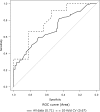Molecularly determined total tumour load in lymph nodes of stage I-II colon cancer patients correlates with high-risk factors. A multicentre prospective study
- PMID: 27447172
- PMCID: PMC5033997
- DOI: 10.1007/s00428-016-1990-1
Molecularly determined total tumour load in lymph nodes of stage I-II colon cancer patients correlates with high-risk factors. A multicentre prospective study
Abstract
Stage I-II (pN0) colorectal cancer patients are surgically treated although up to 25 % will eventually die from disease recurrence. Lymph node (LN) status is an independent prognostic factor in colorectal cancer (CRC), and molecular tumour detection in LN of early-stage CRC patients is associated with an increased risk of disease recurrence and poor survival. This prospective multicentre study aimed to determine the relationship between LN molecular tumour burden and conventional high-risk factors in stage I-II colon cancer patients. A total of 1940 LN from 149 pathologically assessed pN0 colon cancer patients were analysed for the amount of tumour cytokeratin 19 (CK19) messenger RNA (mRNA) with the quantitative reverse transcription loop-mediated isothermal amplification molecular assay One-Step Nucleic Acid Amplification. Patient's total tumour load (TTL) resulted from the sum of all CK19 mRNA tumour copies/μL of each positive LN from the colectomy specimen. A median of 15 LN were procured per case (IQR 12;20). Molecular positivity correlated with high-grade (p < 0.01), mucinous/signet ring type (p = 0.017), male gender (p = 0.02), number of collected LN (p = 0.012) and total LN weight per case (p < 0.01). The TTL was related to pT stage (p = 0.01) and tumour size (p < 0.01) in low-grade tumours. Multivariate logistic regression showed independent correlation of molecular positivity with gender, tumour grade and number of fresh LN [AUC = 0.71 (95 % CI = 0.62-0.79)]. Our results show that lymph node CK19 mRNA detection correlates with classical high-risk factors in stage I-II colon cancer patients. Total tumour load is a quantitative and objective measure that may help to better stage early colon cancer patients.
Keywords: Colorectal neoplasms; Cytokeratin 19; Lymph nodes; Molecular pathology; Neoplasm staging.
Conflict of interest statement
Compliance with ethical standards The study protocol was approved by the Ethics and Scientific committee of each participating institution. All patients signed a written informed consent document for participation in the study. The study was performed in compliance with The Code of Ethics of the World Medical Association (Declaration of Helsinki). Funding Work supported by the Banc de Tumors-Biobanc Hospital Clinic-IDIBAPS and Xarxa de Bancs de Tumors de Catalunya (XBTC), and by grants from the Fundación Científica de la Asociación Española Contra el Cáncer (GCB13131592CAST), Ministerio de Economía y Competitividad (SAF2014–54,453-R), Agència de Gestió d’Ajuts Universitaris i de Recerca (2014SGR135), and by Sysmex Coorp Spain (Sant Just Desvern, Spain). CIBERehd is funded by the Instituto de Salud Carlos III. Conflict of interest The authors declare that they have no competing interests.
Figures




References
-
- Benson AB, Venook AP, Bekaii-Saab T, et al. Colon cancer, version 3.2014. J Natl Compr Cancer Netw. 2014;12:1028–1059. - PubMed
-
- Van Cutsem E, Oliveira J. Primary colon cancer: ESMO clinical recommendations for diagnosis, adjuvant treatment and follow-up. Ann Oncol. 2009;20(Suppl 4):49–50. - PubMed
-
- Rahbari NN, Bork U, Motschall E, et al. Molecular detection of tumor cells in regional lymph nodes is associated with disease recurrence and poor survival in node-negative colorectal cancer: a systematic review and meta-analysis. J Clin Oncol. 2012;30:60–70. doi: 10.1200/JCO.2011.36.9504. - DOI - PubMed
Publication types
MeSH terms
LinkOut - more resources
Full Text Sources
Other Literature Sources

